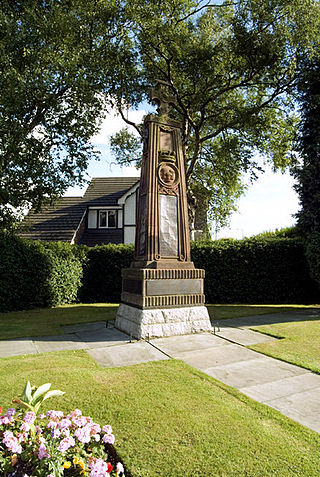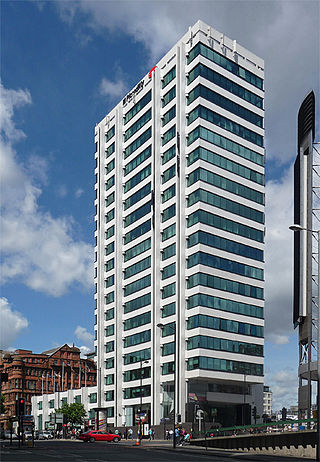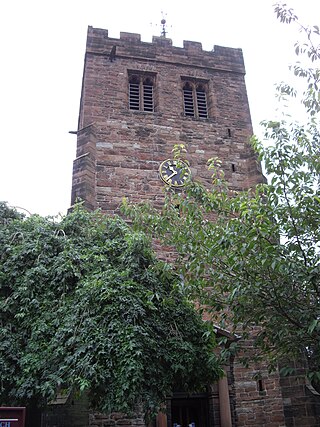
Wilmslow Road is a major road in Manchester, England, running from Parrs Wood northwards to Rusholme. There it becomes Oxford Road and the name changes again to Oxford Street when it crosses the River Medlock and reaches the city centre.

Cheadle Hulme is a suburb in the Metropolitan Borough of Stockport, Greater Manchester, England,. Historically in Cheshire, it is 2.3 miles (3.7 km) south-west of Stockport and 7.5 miles (12.1 km) south-east of Manchester. It lies in the Ladybrook Valley, on the Cheshire Plain, and the drift consists mostly of boulder clay, sands and gravels. In 2011, it had a population of 26,479.

Salford Quays is an area of Salford, Greater Manchester, England, near the end of the Manchester Ship Canal. Previously the site of Manchester Docks, it became one of the first and largest urban regeneration projects in the United Kingdom following the closure of the dockyards in 1982.

The Royal Exchange is a grade II listed building in Manchester, England. It is located in the city centre on the land bounded by St Ann's Square, Exchange Street, Market Street, Cross Street and Old Bank Street. The complex includes the Royal Exchange Theatre and the Royal Exchange Shopping Centre.

Sunlight House is a Grade II listed building in the art deco style on Quay Street in Manchester, England. Completed in 1932 for Joseph Sunlight, at 14 storeys it was the tallest building in Manchester, and the top floors of turrets and multiple dormer windows and mansard roofs create a distinctive skyline.

Piccadilly Gardens is a green space in Manchester city centre, England, on the edge of the Northern Quarter.

City Tower is a 30-storey skyscraper situated in the Piccadilly Gardens area of Manchester city centre in England. As of 2022, it is the tallest office building in Manchester and outside London, and the eighth-tallest building in Manchester, with a roof height of 107 metres (351 ft).

The architecture of Manchester demonstrates a rich variety of architectural styles. The city is a product of the Industrial Revolution and is known as the first modern, industrial city. Manchester is noted for its warehouses, railway viaducts, cotton mills and canals – remnants of its past when the city produced and traded goods. Manchester has minimal Georgian or medieval architecture to speak of and consequently has a vast array of 19th and early 20th-century architecture styles; examples include Palazzo, Neo-Gothic, Venetian Gothic, Edwardian baroque, Art Nouveau, Art Deco and the Neo-Classical.

Abney Hall is a Victorian house surrounded by a park in Cheadle, Greater Manchester, England, built in 1847. It is a Grade II* listed building.

North Tower is a high-rise residential building on Victoria Bridge Street in Salford, England. The building is 23 stories tall with a podium at the base, which gives it a total height of 80 metres (260 ft), making it one of the tallest buildings in Salford. The building is in the City of Salford, just north of the River Irwell and less than 100 metres (330 ft) from Manchester Cathedral on the other side of the river. The top twelve floors contain 96 apartments, with the lower ten used as a Premier Inn hotel.

111 Piccadilly, formerly Rodwell Tower or Rodwell House, is a high rise office development in Manchester, England, owned by Bruntwood, which was opened in 1965. The tower is 64 metres (210 ft) which makes it the joint-sixteenth tallest building in Manchester. The building is located at the corner of Ducie Street. It is the last building in Piccadilly which continues here as London Road.

Bridgewater House, Manchester is a packing and shipping warehouse at 58–60 Whitworth Street, Manchester, England. It is recorded in the National Heritage List for England as a designated Grade II listed building.

Portland Street is a street in Manchester, England, which runs from Piccadilly at its junction with Newton Street south-westwards to Oxford Street at its junction with Chepstow Street. The major buildings of Portland Street include the largest former warehouse in the city centre, Watts Warehouse, the former Bank of England Building and other former warehouses on the corners of Princess Street.

Bridgewater Heights(also known as Liberty Heights, Wakefield Street Tower, or 17 New Wakefield Street) is a skyscraper apartment building in Manchester, England, west of Oxford Street. 17 New Wakefield Street was designed by local architect Stephen Hodder in a clustered architectural form and was completed in September 2012. The skyscraper is situated adjacent to Oxford Road railway station, on the corner of Great Marlborough Street. The skyscraper is 37 storeys high at a height of 109 metres and as of 2022 is the joint 13th-tallest building in Manchester alongside Oxygen Tower 1 in Piccadilly.

St James Buildings is a high-rise, Grade II listed building on Oxford Street, Manchester, England, completed in 1912. The building was constructed in the Edwardian Baroque style and has a Portland stone exterior reaching a maximum height of 60m.
Bruntwood is a family-owned property company offering office space, serviced offices, retail space and virtual offices in the north of England and Birmingham in the United Kingdom. They own several high-profile buildings in the Manchester area, as well as in Liverpool, Leeds and Birmingham.

St Andrew's Church is in the centre of the town of Penrith, Cumbria, England. It is an active Anglican parish church in the deanery of Penrith, the archdeaconry of Carlisle, and the diocese of Carlisle. The parishes of Penrith ; St John, Newton Reigny and St John the Evangelist, Plumpton Wall are united in a single benefice. The church is recorded in the National Heritage List for England as a designated Grade I listed building. At one time St Andrew's had a chapel of ease or mission church in Brougham Street in the Penrith suburb of Castletown called St Saviours and another, All Hallows at the hamlet of Bowscar just to the north of the town.

Bank Chambers is an office building on Portland Street, Manchester, England. Its heavy and imposing appearance gives away its previous use as a bullion bank vault by the Bank of England. The Bank of England vacated the building in the 1990s and the building is now used as offices.






















